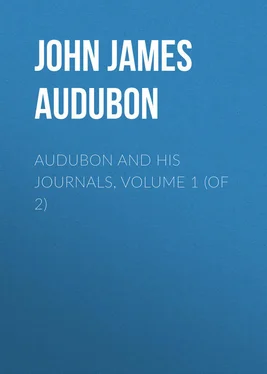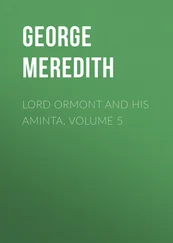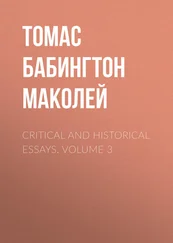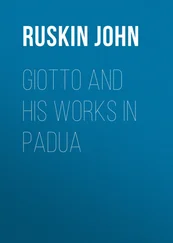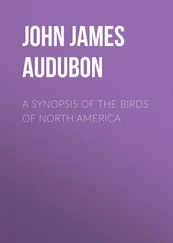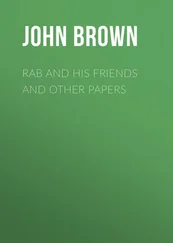John Audubon - Audubon and his Journals, Volume 1 (of 2)
Здесь есть возможность читать онлайн «John Audubon - Audubon and his Journals, Volume 1 (of 2)» — ознакомительный отрывок электронной книги совершенно бесплатно, а после прочтения отрывка купить полную версию. В некоторых случаях можно слушать аудио, скачать через торрент в формате fb2 и присутствует краткое содержание. Жанр: foreign_antique, foreign_prose, на английском языке. Описание произведения, (предисловие) а так же отзывы посетителей доступны на портале библиотеки ЛибКат.
- Название:Audubon and his Journals, Volume 1 (of 2)
- Автор:
- Жанр:
- Год:неизвестен
- ISBN:нет данных
- Рейтинг книги:5 / 5. Голосов: 1
-
Избранное:Добавить в избранное
- Отзывы:
-
Ваша оценка:
- 100
- 1
- 2
- 3
- 4
- 5
Audubon and his Journals, Volume 1 (of 2): краткое содержание, описание и аннотация
Предлагаем к чтению аннотацию, описание, краткое содержание или предисловие (зависит от того, что написал сам автор книги «Audubon and his Journals, Volume 1 (of 2)»). Если вы не нашли необходимую информацию о книге — напишите в комментариях, мы постараемся отыскать её.
Audubon and his Journals, Volume 1 (of 2) — читать онлайн ознакомительный отрывок
Ниже представлен текст книги, разбитый по страницам. Система сохранения места последней прочитанной страницы, позволяет с удобством читать онлайн бесплатно книгу «Audubon and his Journals, Volume 1 (of 2)», без необходимости каждый раз заново искать на чём Вы остановились. Поставьте закладку, и сможете в любой момент перейти на страницу, на которой закончили чтение.
Интервал:
Закладка:
Louisville was speedily quitted for Shippingport, where Audubon engaged a room for Victor and himself, and painted all winter (1823-24) at birds, landscapes, portraits, and even signs.
Shippingport was then a small village with mills, and was largely owned by the Tarascons and Berthouds, the latter living in the mansion of the place, and possessed of a very beautiful garden. Steamers and boats for the river traffic were built here, and it was a stirring place for its size, situated on the Falls of the Ohio, about two miles from Louisville then, but now part of that city. With forests and river to solace his anxieties, another season was passed by the man whose whole energies were now bent on placing his work before the best judges in Europe. This winter too, he lost one of his best and dearest friends, Madame Berthoud; how he felt this parting his own words best tell: "January 20, 1824. I arose this morning by that transparent light which is the effect of the moon before dawn, and saw Dr. Middleton passing at full gallop towards the white house; I followed – alas! my old friend was dead! What a void in the world for me! I was silent; many tears fell from my eyes, accustomed to sorrow. It was impossible for me to work; my heart, restless, moved from point to point all round the compass of my life. Ah, Lucy! what have I felt to-day! how can I bear the loss of our truest friend? This has been a sad day, most truly; I have spent it thinking, thinking, learning, weighing my thoughts, and quite sick of life. I wished I had been as quiet as my venerable friend, as she lay for the last time in her room."
As I turn over the pages of this volume 29 29 The before-mentioned journal, 1822-24.
from which only a few extracts have been taken, well do I understand the mental suffering of which it tells so constantly. Poverty for himself, Audubon did not mind, but for those he loved it was a great and bitter trial to him. His keenly sensitive nature was wounded on every hand; no one but his wife, from whom he was now absent, had any faith in him or his genius. He never became indifferent, as most of us do, to the coldness of those who had in earlier days sought him, not for what he was , but for what he had . Chivalrous, generous, and courteous to his heart's core, he could not believe others less so, till painful experiences taught him; then he was grieved, hurt, but never imbittered; and more marvellous yet, with his faith in his fellows as strong as ever, again and again he subjected himself to the same treatment. This was not stupidity, nor dulness of perception; it was that always, even to the end, Audubon kept the freshness of childhood; he was one of those who had "the secret of youth;" he was "old in years only, his heart was young. The earth was fair; plants still bloomed, and birds still sang for him." 30 30 (With slight alterations) from "Bird Life," by F. M. Chapman, 1897, p. 13.
It has been hard for me to keep from copying much from this journal, but I have felt it too sacred. Some would see in it the very heart of the man who wrote it, but to others – and the greater number – it would be, as I have decided to leave it, a sealed book.
Early in March, 1824, Audubon left Shippingport for Philadelphia, Victor remaining in the counting-house of Mr. Berthoud. He had some money, with which he decided to take lessons in painting either from Rembrandt Peale or Thomas Sully. He much preferred the latter both as artist and friend, and he remained in Philadelphia from April until August of the same year. This visit was marked by his introduction to Charles Lucien Bonaparte 31 31 Prince of Musignano, and subsequently a distinguished ornithologist. In March, 1824, Bonaparte was just publishing his "Observations on the Nomenclature of Wilson's Ornithology," which ran through the "Journal of the Academy of Natural Sciences," of Philadelphia, from April 5, 1824, to Aug. 25, 1825, in five parts. This was preliminary to Bonaparte's "American Ornithology," which appeared in four quarto vols., 1825-33, to his "Synopsis," of 1828, and to his "Comparative List," of 1838. – E. C.
and Edward Harris, both of whom became life-long friends, especially Mr. Harris, with whom he corresponded frequently when they were separated, and with whom he made many journeys, the most prolonged and important being that to the Yellowstone in 1843. To copy again: "April 10, 1824. I was introduced to the son of Lucien Bonaparte, nephew of Napoleon, a great ornithologist, I was told. He remained two hours, went out, and returned with two Italian gentlemen, and their comments made me very contented." That evening he was taken to the Philosophical Academy 32 32 Probably the Academy of Natural Sciences.
where the drawings were greatly admired, and their author says: " I do not think much of them except when in the very act of drawing them." At this meeting Mr. George Ord met Audubon and objected strongly to the birds and plants being drawn together, "but spoke well of them otherwise." Mr. Ord was one of those (of the very few, I might say) who disliked the naturalist from first to last, 33 33 Ord had edited the posthumous vols. viii. and ix. of "Wilson's Ornithology," which appeared in 1814; and in 1824 was engaged upon that edition of Wilson which was published in 3 vols. 8vo, in 1828-29, with a folio atlas of 76 plates. This is probably enough to account for his attitude toward Audubon. – E. C.
who was perhaps, his bitterest enemy. In later years Dr. John Bachman resented his conduct, and wrote a very trenchant reply 34 34 "Defence of Audubon," by John Bachman. "Bucks Co. Intelligencer," 1835, and other papers.
to one of Mr. Ord's published articles about Audubon; but there is no word of anger anywhere in the letters or journals, only of regret or pain. 35 35 Almost the only other enemy Audubon appears to have ever had in public print was Charles Waterton, who vehemently assailed him in "Loudon's Magazine of Natural History," vi. 1833, pp. 215-218, and vii., 1834, pp. 66-74. Audubon was warmly defended by his son Victor in the same magazine, vi. 1833, p. 369, and at greater length by "R. B.," ibid. , pp. 369-372. Dr. Coues characterizes Waterton's attack as "flippant and supercilious animadversion," in "Birds of the Colorado Valley," 1878, p. 622. The present is hardly the occasion to bring up the countless reviews and notices of Audubon's published life-work; but a few references I have at hand may be given. One of the earliest, if not the first, appeared in the "Edinburgh Journal of Science," vi. p. 184 (1827). In 1828, Audubon himself published "An Account of the Method of Drawing Birds," etc., in the same Journal, viii., pp. 48-54. The "Report of a Committee appointed by the Lyceum of Natural History of New York to examine the splendid work of Mr. Audubon," etc., appeared in "Silliman's Journal," xvi., 1829, pp. 353, 354. His friend William Swainson published some highly commendatory and justly appreciative articles on the same subject in "Loudon's Magazine," i., 1829, pp. 43-52, and in the "Edinburgh New Philosophical Journal," x., 1831, pp. 317-332, under the pseudonym "Ornithophilus." Another anonymous review, highly laudatory, appeared in the same Journal, xviii., 1834, pp. 131-144. Dr. John Bachman defended the truthfulness of Audubon's drawings in the "Journal of the Boston Society of Natural History," i. 1834, pp. 15-31. One of the most extended notices appeared anonymously in the "North American Review," July, 1835, pp. 194-231; and another signed "B," in "Loudon's Magazine," viii., 1835, PP. 184-190. In Germany, "Isis von Oken" contained others, xxx., 1837, pp. 922-928, xxxv., 1842, pp. 157, 158; and xxxvii., 1844, pp. 713-718. "Silliman's Journal" again reviewed the work in xlii., 1842, pp. 130-136. – E. C.
Интервал:
Закладка:
Похожие книги на «Audubon and his Journals, Volume 1 (of 2)»
Представляем Вашему вниманию похожие книги на «Audubon and his Journals, Volume 1 (of 2)» списком для выбора. Мы отобрали схожую по названию и смыслу литературу в надежде предоставить читателям больше вариантов отыскать новые, интересные, ещё непрочитанные произведения.
Обсуждение, отзывы о книге «Audubon and his Journals, Volume 1 (of 2)» и просто собственные мнения читателей. Оставьте ваши комментарии, напишите, что Вы думаете о произведении, его смысле или главных героях. Укажите что конкретно понравилось, а что нет, и почему Вы так считаете.
